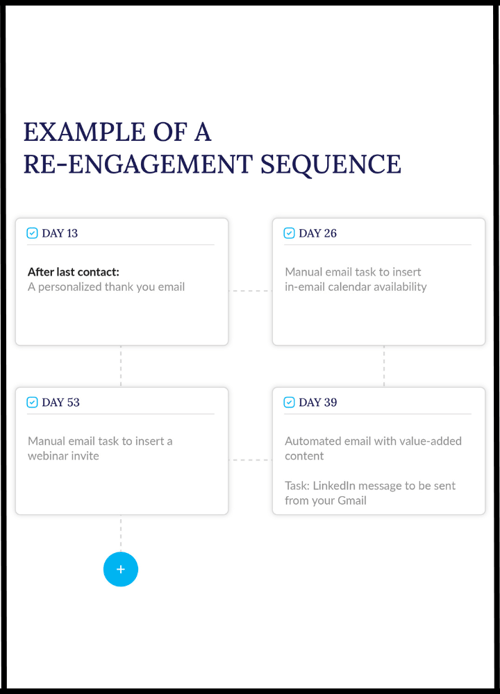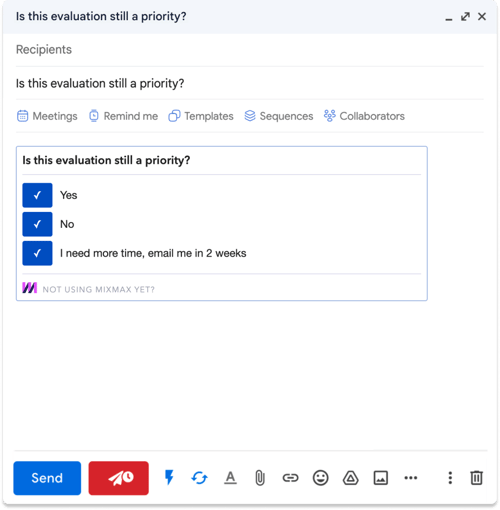November 22, 2023
23 Effective Sales Closing Lines & Techniques That Seal the Deal
.png)
- 13 effective sales closing lines (and why they work)
- Sales techniques that lead to an eventual close
- Sales closing mistakes to avoid
- Close more deals with Mixmax
All your team’s efforts boil down to successfully closing a sale.
If your AEs spend weeks or even months with a lead and it all ends in a dead end, it can be very discouraging.
Yes, rejection is a massive part of sales, but what if your team could get a leg up?
(Pause for intrigue)
What if there are certain sales closing lines and techniques that could help them seal the deal?
(Pause for more intrigue)
What if there are mistakes they’re making that are hurting their chances of closing the sale?
We interviewed our Senior Sales Director, Mackenzie Prinslow, here at Mixmax and she gave us some juicy insights about what works–and what to avoid–when trying to close a sale.
Let’s take a look.
23 effective sales closing lines (and why they work)
These sales closing phrases will give your team the boost they need to move the sale along. They can be added to your email sequence templates and personalized for each prospect.
1. "Do you see how [COMPANY NAME/PRODUCT] can help solve [PAIN POINTS]?"
Why this works: You’re making a clear connection between their pain points and the fact that your company/product is the solution.
2. "I know you said ideally you’d have a solution in place by [DATE]. Working backward from that date, and accounting for implementation and onboarding, we'd need to have a signed contract by [DATE]. Can you commit to signing by then?"
Why this works: You’re not leaving any room for ambiguity. You’re giving them a clear deadline to close the deal so they can have their solution up and running by their desired date.
3. "I’m excited to start working together! If there are no other questions or concerns, I’ll go ahead and send over the contract today to [SIGNING AUTHORITY]."
Why this works: This puts pressure to move things forward. If they have concerns, you’re forcing them to tell you about them, and if not, there shouldn’t be anything else holding them back.
4. "If I can get [PROSPECT’S REQUEST] approved, are there any other hurdles to getting you to move forward?"
Why this works: You’re committing to give them what they want, which should satisfy them and lead to a closed sale.
5. "It seems like [COMPANY NAME/PRODUCT] will help your team meet their goals. Is there any reason why you wouldn’t want to move forward?"
Why this works: You’re encouraging them to voice any concerns they may have, and if they don’t have any, you can start concluding the sale.
6. "If [OBJECTION] wasn’t a factor, would you be ready to get started?"
Why this works: You’re letting them know that you understand their objection and that you’re willing to negotiate/compromise to move forward with the deal.
7. "Are you thinking of going with X Tier or Y Tier?"
Why this works: You’re forcing them to choose between the different options you have available, which makes it easier to discuss the next steps.
8. "If we implement by X date, I estimate you can start seeing ROI by March. That means we’d need to close by X date. Is that enough time for you to make a decision?"
Why this works: You’re moving the sale along while reducing some of the risks by bringing up ROI.
9. "I know X is a huge priority for your team next quarter. If we close by X date, this solution will help you meet your goals."
Why this works: You’re reiterating that they will have a successful next quarter if they invest in your product/service by a certain date, which nudges them toward closing the sale.
10. "Let’s set up a trial so your team can get a hands-on experience with [COMPANY NAME/PRODUCT]."
Why this works: This is a casual and friendly approach to closing a deal, and it gives prospects the impression that there isn’t much risk involved by agreeing to it.
11. "We came up with your preferred arrangement. Let’s schedule a meeting at [TIME] on [DAY] and start with the execution."
Why this works: This shows that you’ve solved whatever concern that was holding your prospect back and it is now time to finalize the sale.
12. "Do you think it might work? I can send over some paperwork this afternoon if everything looks good on your end."
Why this works: The fact that you can send over the paperwork that very same day gives the impression that closing the sale will be seamless and easy for everyone.
13. “Is this a more profitable approach that fits your budget? If yes, I’m more than glad to make follow-up plans.”
Why this works: You’re showing that you’re flexible and have made arrangements to fit their budget. And since the budget concern has been resolved, you can move forward with the deal.
14. “Based on what we've discussed, can we agree this is a good fit for your needs? If so, I can get the final proposal to you by tomorrow."
Why this works: It seeks confirmation on the fit for their needs, and if affirmative, provides a quick turnaround time for the next steps, emphasizing efficiency and momentum.
15. “Given the benefits we've outlined, shall we take the next step and finalize the details?"
Why this works: This phrase moves the conversation towards action by assuming that the benefits have been understood and accepted.
16. “How does this sound for a plan of action? If you agree, I can draft our agreement today."
Why this works: Offering a 'plan of action' can make the prospect feel like they're about to embark on a journey with a roadmap, and the prompt offer to draft the agreement shows readiness and enthusiasm.
17. “Can we lock in this decision today to ensure we meet your project timeline?"
Why this works: It creates a sense of urgency and shows that you're considerate of their time and project schedule.
18. “If we can resolve your main concerns, can we proceed to the next stage?"
Why this works: This closing line is designed to directly address any remaining barriers without being too pushy.
19 “Should we pencil in a start date, so your team can begin experiencing the benefits as soon as possible?"
Why this works: It's a softer close that assumes the sale and also communicates the benefits of starting sooner rather than later.
20. ”Shall we move forward with the plan as discussed? I'm ready to make it official whenever you are."
Why this works: This phrase communicates preparedness and a collaborative spirit, suggesting that you're both on the same page.
21. ”Do you feel comfortable with the proposal? If so, I can secure your spot in our schedule now."
Why this works: This closing line is focused on the prospect's comfort level, and a sense of exclusivity with 'securing a spot', which can be an effective motivator.
22. ”Is there anything else you need from me, or are we ready to move ahead with the partnership?"
Why this works: It gives the prospect a chance to request further information while simultaneously nudging towards the commencement of a partnership.
23. ”What timeline would you be comfortable with for making a decision? I want to ensure we're moving at a pace that suits you."
Why this works: This shows respect for the prospect's decision-making process while subtly pressing for a timeline, which can help prevent the sale from stalling.
Sales techniques that lead to an eventual close
Closing a sale doesn’t happen overnight. Not for us mere mortals, anyway.
There are many hurdles along the way, but if you coach your team with the proper sales techniques from the start, they’ll be better equipped to lock in the deal.
Here are a few sales techniques our sales manager swears by.
Start with a strong discovery call
A strong start makes for a strong end. Even before they hop on the discovery call, your AEs should do thorough research to understand the prospect’s unique challenges. During the call, they should get as much information about the prospect as possible to really understand what their specific needs are.
Devise a mutual action plan
Your AEs shouldn’t end a call without a plan to follow up. They can use the info they’ve gathered in the discovery to set realistic timelines and ensure they have a hard date and time set for the next steps to stay on track.
Pro tip: Calendaring tools such as Mixmax’s one-click meetings will help your team insert specific timeslots directly into an email message so it’s easy for prospects to book a follow-up call.
Understand their security & procurement process
One of the sales techniques that is often overlooked is asking the prospect about their security and procurement process. Discussing this in the beginning stages of the sales process ensures there are no unexpected roadblocks when it comes time to closing.
Be prepared for objections
Your AEs should always be prepared to a) understand and b) overcome common sales objections. The key is active listening and validating the prospect’s objections and concerns. Then they can move on to reassuring the prospect with relevant rebuttals.
Re-engage prospects
If your AEs don’t actively follow up with unresponsive prospects, they are missing opportunities. They should try to re-engage prospects to get things back on track, even if it means looping the SDR back in and enrolling the prospect in a re-engagement sequence.
Here's an example of a re-engagement sequence you can set up in Mixmax:

Pro tip: If your team isn’t getting answers from follow-up sales emails, try using Mixmax’s one-click polls to make it easier for prospects to respond. Here’s an example of a follow-up poll:

Sales closing mistakes to avoid
Your AEs can have the biggest and baddest sales techniques under their belts and the best sales closing lines this world has ever seen. BUT if they’re making these mistakes, it’s hurting their chances of closing that sale.
Asking assumptive close questions too early
Don’t get us wrong, assumptive close questions work. But if your AEs are pushy/overly confident too early in the game, it can turn prospects off. Assumptive closing questions should only be used if your sales rep is actually confident that they can close the sale.
Here are a few assumptive close questions that you may want to avoid early on:
- "When can we expect the signed contract back from you?"
- "Which team members shall we include in our onboarding session?"
- "How many user licenses will you be needing for our software?"
- "What date should we set for the implementation kickoff meeting?"
Again, these can be used if you're almost certain that you will close the deal. AKA to be used with caution.
Leaving next steps open-ended
If your team isn’t clearly discussing next steps after key touch points (after a demo, for example), they will end up in a situation where they’re trying to get the prospect to close but it doesn’t coincide with his/her plans.
Here are a few examples of how your team can secure next steps:
Concrete commitments: At the end of every call or demo, nail down the next meeting date and time. Don't leave it at "I'll send you my availability." Instead, book it on the spot.
Mutual to-do lists: Assign homework for both sides. When they have tasks to complete, and so do you, it creates a partnership dynamic and a sense of momentum.Set
Deadlines: Not just for the next meeting, but for all interim steps. If they need to review a proposal, ask when they can finish the review, and suggest a follow-up right after.
|
|
Being single-threaded
Your AEs should not only interact with one contact person. You want multiple stakeholders involved in the sales cycle, because you’ll have more people to get the evaluation done and close the sale. Plus, more people in the company will be invested in using your product.
Krysten Conner on multi-threading best practices
Note: If you’re only dealing with one person, they can easily leave the company and your AE will have to start the whole sales process again with someone new.
Your reps when they find out they have to start over with someone new ⬇️
Offering too many options
The problem with giving too many options is overwhelming potential customers. And when that happens, the sale is as good as dead.
Your AEs should offer the best fit for the prospect based on the information they gathered during the discovery call.
Giving a generic demo
Your team should use ALL the info they’ve gathered during the discovery process to offer the prospect a customized demo instead of a generic one that doesn’t speak to their pain points. The more focused the demo, the more likely the sale.
Every feature you highlight should tie back to a need or a pain point your prospect has confided in you.
Here's an example of a custom demo based on the prospect's specific pain point:
Instead of: "This feature lets you create email sequences for your campaigns."
Try: "You've highlighted how much of your team's time is wasted crafting follow-up emails day in and day out. With this feature, you can build personalized email sequences once, automate the follow-up process, and give your team the freedom to focus on closing deals rather than managing their inbox."
Weave their current challenges and future goals into your demo narrative. Show them a day in the life with your solution—how it turns their pain points into gain points.
Pitching features instead of value
When your Account Executives (AEs) are in the throes of a sale, there's a natural inclination to dive deep into the product—its ins and outs, bells and whistles, the shiny new features.
And why not? Your product rocks!
But here's the kicker: your prospects aren't looking for a feature dump; they're shopping for solutions, outcomes, and that oh-so-sweet value.
Let's put it this way:
Feature-focused: "Our software has the latest AI-driven analytics with real-time data processing."
VS.
Value-driven: "You'll be able to understand your customer behavior in real-time, allowing for swift business decisions that could significantly increase your conversion rates."
See the difference? It’s not about the AI; it’s about the outcome it creates.
Here's another example:
Feature-focused: "This model comes with 256-bit encryption and a built-in VPN."
VS.
Value-driven: "Your data stays ironclad secure, so you can meet compliance standards and avoid costly breaches that could set your business back."
Basically, AEs need to pivot from features to storytelling.
Close more deals with Mixmax
If you want to keep prospects engaged and close more sales, our sales engagement solution can help your team get there.
With Mixmax as your secret weapon, you can:
- Boost email reply rate by up to 25% with polls and surveys
- Secure more follow-ups by eliminating the back-and-forth with one-click meetings
- Land more replies and meetings with personalized email sequences
Not convinced? See how Mixmax helped this SaaStr sales leader close over $1 million in revenue in just 90 days.
You deserve a spike in replies, meetings booked, and deals won.

Rita Melkonian
Rita Melkonian is the content marketing manager @ Mixmax with 8+ years of experience in the world of SaaS and automation technology. In her free time, she obsesses over interior design and eats her way through different continents with her husband & daughter (whose fave word is "no").



.png?width=450&height=250&name=Episode%20Graphic%20(1).png)
